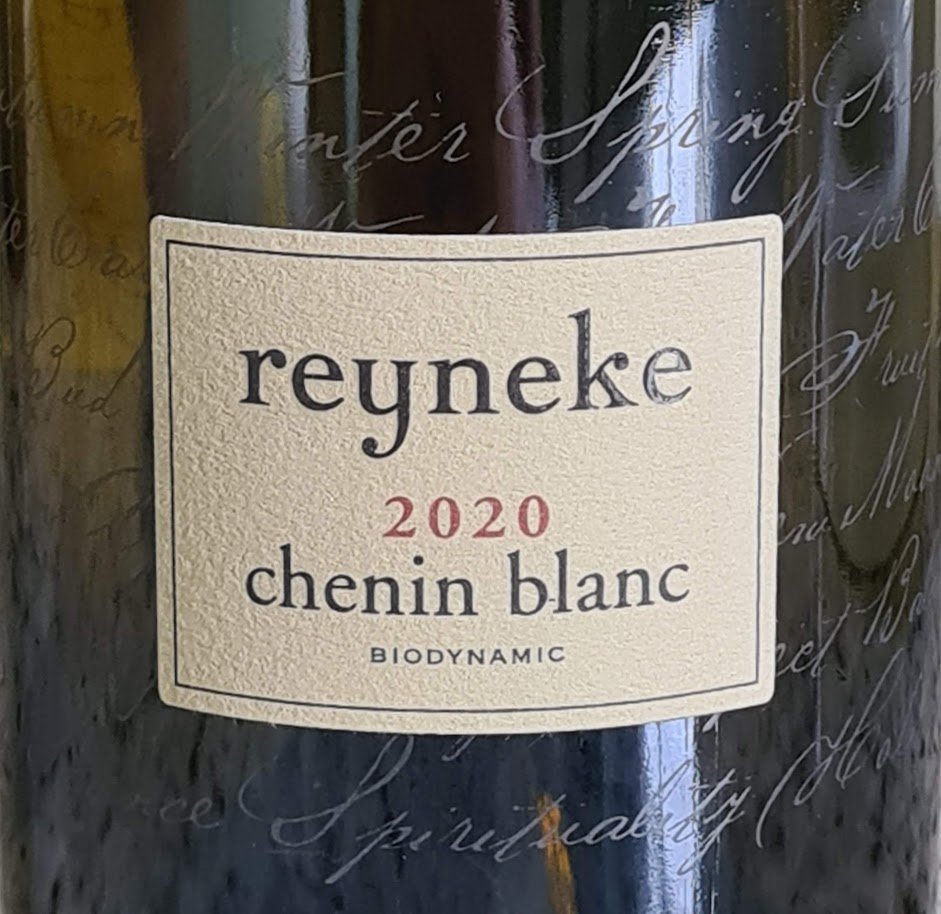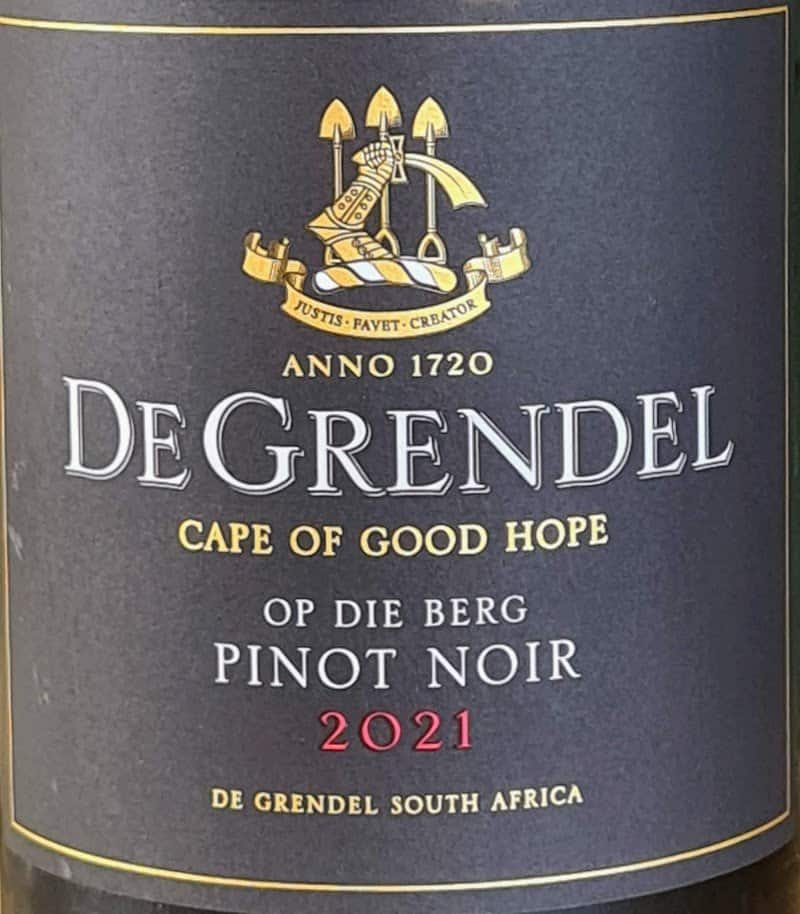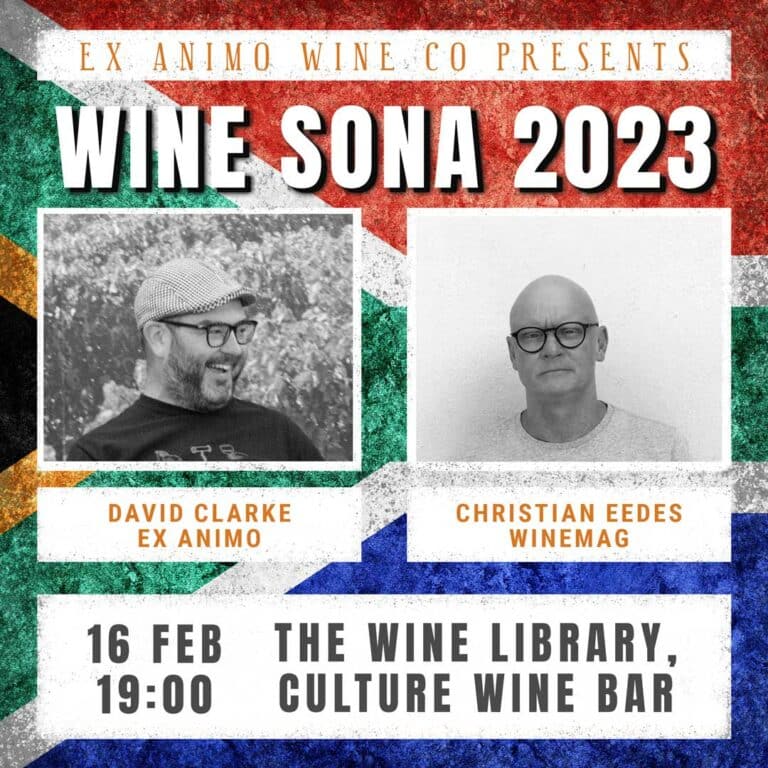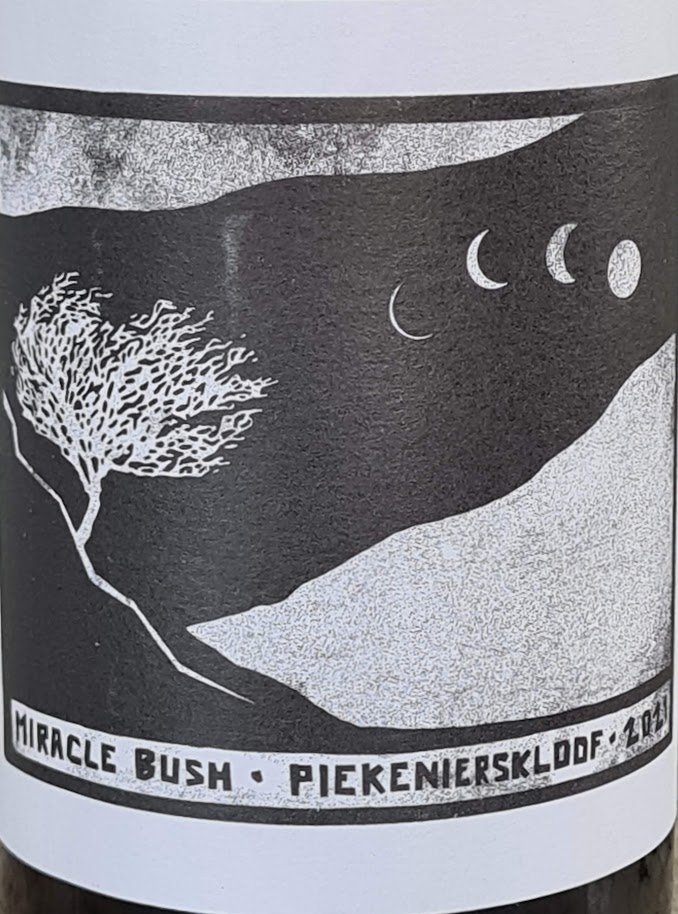
Boschendal in Franschhoek has announced Eric Bulpitt as its new executive chef. Bulpitt has previously worked at Pierneef à La Motte, FABER at Avondale and The Restaurant at Newton Johnson. Boschendal’s The Werf Restaurant was awarded an Eat Out star at the 2022 Eat Out Woolworths Restaurant Awards.
 Pieter Walser, winner of the Grand Prix at the Wine Label Design Awards 2015 for his BLANKbottle range of wine, continues on his nonconformist way. Makstokkie 2021 is from Swartland Verdelho – ungrafted, echela trellised vines planted on schist soils on a steep slope outside Riebeek Kasteel, to be precise.
Pieter Walser, winner of the Grand Prix at the Wine Label Design Awards 2015 for his BLANKbottle range of wine, continues on his nonconformist way. Makstokkie 2021 is from Swartland Verdelho – ungrafted, echela trellised vines planted on schist soils on a steep slope outside Riebeek Kasteel, to be precise.
Spontaneously fermented and matured for 10 months in older oak, the nose shows subtle and elusive notes of pear, peach and dried herbs while the palate is taut and precise – great concentration and driving acidity before a saline, uncompromisingly dry finish. Price: R295 a bottle.
CE’s rating: 95/100.
Check out our South African wine ratings database.
Malie McGregor started as winemaker at Stellenbosch property Cavalli in December 2021 after a previous stint at Rust en Vrede, her first wines from the 2022 harvest now released. Tasting notes and ratings as follows:
 Cavalli Reserve Chenin Blanc 2022
Cavalli Reserve Chenin Blanc 2022
Price: R185
This replaces the wine previously known as Filly, the 2020 vintage of which was not just best in category but also best white wine overall in the Prescient Reports of 2021. The greater part of this vintage was matured for six months in barrel, 16% new (includes an unoaked portion of approximately 15%).
The nose shows top notes of flowers and herbs before pear, peach and lemon while the palate has a dense core of fruit to go with an arresting line of acidity and a saline finish. Focused and tense.
CE’s rating: 94/100.
Cavalli Reserve Chardonnay 2022
Price: R200
New. Matured for 10 months in barrel, 27% new. Lime, lemon and vanilla on the nose while the palate shows dense fruit and zippy acidity before a suitably dry finish. Clean and correct but lacking some detail which may still emerge with time in bottle.
CE’s rating: 90/100.
Cavalli Cremello 2022
Price: R235
43% Chenin Blanc, 25% Chardonnay, 21% Verdelho and 11% Viognier. The nose is complex with some flinty reduction preceding pear, peach, citrus, floral perfume, a hint of vanilla and spice while the palate has great fruit concentration matched by zippy acidity, the finish long and savoury. Full without sacrificing nuance.
CE’s rating: 93/100.
Check out our South African wine ratings database.
I have a nagging worry about the ability of South Africa’s best examples of Chenin Blanc to age with benefit but a wine that seems to be tracking well is the 2019 from Stellenbosch biodynamic producer Reyneke – I found it primary to the point of inchoate (although still good enough to rate 91) in June 2020 while a bottle enjoyed a few days ago was just outstanding.
 This prompted me to track down a bottle of 2020 still available in the trade (price: R255 a bottle). Grapes from two blocks planted in 1974 and 1976 respectively, winemaking involved spontaneous fermentation in second-fill French barrique as well as 2500-litre foudrés before 10 months of maturation.
This prompted me to track down a bottle of 2020 still available in the trade (price: R255 a bottle). Grapes from two blocks planted in 1974 and 1976 respectively, winemaking involved spontaneous fermentation in second-fill French barrique as well as 2500-litre foudrés before 10 months of maturation.
Complex aromas of peach, tangerine, hay, wet wool and some flintiness while the palate has great depth of fruit, well integrated acidity and a savoury finish – not as punchy as some of its counterparts but certainly possessing layers of flavour to go with nice weight and texture. The farm is already selling 2022 which I suspect should not be broached until at least 2025.
CE’s rating: 93/100.
Check out our South African wine ratings database.
 Cape Town specialist wine retailer Caroline Rillema and husband Ray Kilian own a 3.5ha property near Cape South Coast village of Baardskeerdersbos, the resulting wines designated as W.O. Cape Agulhas.
Cape Town specialist wine retailer Caroline Rillema and husband Ray Kilian own a 3.5ha property near Cape South Coast village of Baardskeerdersbos, the resulting wines designated as W.O. Cape Agulhas.
In the case of the 2021, the wine was made at Black Oystercatcher in Elim, the blend made up of 60% Sauvignon Blanc and 40% Semillon, these crushed together before maturation lasting 10 months in older barrels.
The wine is a quintessential example of what this area produces with the nose showing lime, green apple, white peach, hay and fresh herbs while the palate has a dense core of fruit, arresting acidity and an intensely savoury finish. Striking in its purity and drive. Price: R195 a bottle.
CE’s rating: 91/100.
Check out our South African wine ratings database.

The death of Dave Hughes a little over a week ago was hardly unexpected, but it brought with it a very clear sense of the gates swinging shut on an era. His was the last visible presence of a remarkable band of people who shaped the wine industry as we know it today. Mostly they shared a stint at Stellenbosch Farmers’ Winery (SFW) in the days when the company (owned at the time by South African Breweries) transformed the consumption of wine from a regional – largely fortified – beverage to a drink that enjoyed middle class respectability.
They did so by making wines which could be enjoyed easily, without the hype and arcane bumpf that thrives today, and then by getting these new styles of unfortified wines into the national market. They could never have done that without the marketing power and consumer-facing skills of SAB. But SAB could never have done it without their vision, and their ability to take the best of whatever was planted in reasonable proximity to their Stellenbosch cellars and turn the fruit into quaffable but not inconsequential wine.
The heyday of the trade built by SFW was the first half of the 1960s. Its high-volume brands included many names which are still with us (some in a much attenuated form). Chateau Libertas, Tassenberg, Zonnebloem, Nederburg, but also Virginia, Oom Tas and Lieberstein, the latter three sold in returnable glass and in quantities which have never really been rivalled since. Ronnie Melck (who died in the 1990s) and Duimpie Bailey (who died in 2021) built the production side of the wine business. Dave Hughes, who arrived in the Cape from what was then Rhodesia, focussed on consumer engagement.
It was a time of great transition in the wine industry: legislation drafted in the late 1960s/early 1970s, and which became law in 1973, facilitated the development of independent wineries and the establishment of wine estates. Even before the concept was fully understood, the estate wine trade began to grow, led by a triumvirate of rebels (Delheim’s Spatz Sterling, Spier’s Niel Joubert and Simonsig’s Frans Malan). They launched the Stellenbosch Wine Route in competition with the brands with which SFW had built the wine market. Initially SFW tried to stifle them, boycotting their fruit in an endeavour to kill the threat posed by the estate wine trade. This was not SFW’s finest moment, and it was doomed to failure.
Suddenly the historic properties which hitherto had depended on the beneficence of SFW simply to survive had their own route to market. As they grew, SFW lost access to some of the Coastal Region’s finest vineyards. Its response was to industrialise the production of even its most prestigious wines: the dichotomy between perceived artisanal and perceived commercial dates from this quite recent moment in our modern wine history. Consider this: in 1973 Kanonkop bottled its first wines under its own label. As a consequence, and over time, this deprived SFW of the fruit it had used to make some of its best wines in the 1950s and 1960s.
Initially the change was slow, even tentative. The wholesale merchants focused on their growing bag-in-box business, the estates on their wine routes, their mail-and-rail. By the 1980s, as international markets began to close, the pressure cooker of isolation played its own crucial role. So did domestic wine tourism. Looking back, it all seems so obvious.
It’s easy to blame the clumsy protectionism of SFW and SAB as they tried to close down the independents before their offerings obtained traction in the market. It was how they did business, and it fitted well with the general kragdadigheid of the era. By 1979, when PW Botha overruled his own Minister of Trade and Industry and allowed the creation of Cape Wines and Distillers – a virtual monopoly in the wine and spirits production sector – there was no place left for nuanced engagement. The massive corporatised machine was always going to move across the battlefield like a tank, expecting to mow down whatever stood in its path. The best growers, on the best sites, became the guerillas, agile, fleet-of-foot, able to hide in the mountains and the impenetrable jungle where marketing departments and large advertising agencies never go. We all know how these war-games end.
 The Ceres Plateau captures the imagination as a wine-growing area, the vineyards planted some 1000m above sea level in the Witzenberg, 40km north of the town of Ceres itself. The climate is continental and winter temperatures frequently dropping below zero. Could this appellation, for instance, lend itself to less ordinary Pinot Noir?
The Ceres Plateau captures the imagination as a wine-growing area, the vineyards planted some 1000m above sea level in the Witzenberg, 40km north of the town of Ceres itself. The climate is continental and winter temperatures frequently dropping below zero. Could this appellation, for instance, lend itself to less ordinary Pinot Noir?
De Grendel have been working with Pinot from here for a while and the current-release 2021 (price: R275 a bottle) again fascinates. 70% whole-bunch fermented, the juice was inoculated, malolactic fermentation taking place in new barrels, before maturation lasting 13 months in older barrels.
Initially the nose shows top notes of musk and rose before red and black cherry while fynbos, white pepper and even a little meatiness emerge with time in glass. The palate shows good clarity of fruit, lemon-like acidity and lightly grippy tannins. It’s deftly done but lacks some of the heft of previous vintages – alcohol is 12.82%.
CE’s rating: 92/100.
Check out our South African wine ratings database.

In recent years Cape pinot noir has shared in the large price increases common to most top-end wine, perhaps especially reds. It hasn’t reached, though, the stratospheric levels of, especially but not only, the cab-based Stellenbosch wines that have been particularly vulnerable to ego- and greed-driven producer ambitions (oh, all right, let’s credit “the market”). Actually, I wonder if this isn’t going to be changing soon for pinot, with the best examples getting ever pricier. Why not? Cape pinot reputations are good, locally and internationally, and there are many red burgundy-lovers being pushed aside into the (relative) gutter as the price juggernaut there moves on relentlessly.
The most illustrious top local versions are already keenly taken up, it seems from a glance at what’s available online, even as prices edge towards (and occasionally past) R1000 per bottle. Names like Storm, Crystallum, Newton Johnson, Hamilton Russell, Paul Cluver and a good few others seldom seem to even reach the shelves (locally at least) before they are eagerly grabbed. Even among the slightly less lauded labels, prices over R500 per bottle are common.
Modestly priced alternatives are not easy to find, however – unlike with, say, cabernet sauvignon and shiraz. Probably, I suppose, because most of the somewhat lesser pinot fruit goes to support the huge and lucrative demand for sparkling wine. So when, feeling in the mood for a coolable cinsault the other day, I called in at Woolworths to get a few bottles of Marras The Trickster (R99), I was surprised to notice on an adjacent shelf two bottles of pinot for little more than that, one from the rather grand DeMorgenzon estate, the other from Haute Cabrière.
It seemed a good idea to see if I could find a few more at that sort of price to report on. The Pick n Pay supermarket in the same shopping mall gave me the cheapest one I found in my admittedly brief survey, from Southern Road (a label which I’d never heard of). (Incidentally, and with not untypical incompetence for PnP, which is undoubtedly the poorest of the supermakets in their wine offering, the few pinots were jumbled up with the pinotages, under big placards, one of which announced “Pino Noir”.) And at my excellent local independent, Constantia Wine and Craft in Plumstead, Cape Town, where there was a good selection of pinots, I found one from Kruger Family Wines – always an impressive and good value range. All but one of these from 2021.
The result of the little tasting was not without some impressive results. Unfortunately, the Southern Road (R95) didn’t shape up to the other three. As far as I can tell, Southern Road is a brand connected in some way with Nuiba Wines and with an out-of-date website, which says their wines are from the Swartland – though this one is WO McGregor – not the first place where one would expect to find pinot vines. It’s not a bad cheap anonymous red, both a touch sweetly confected and a little green and lean, with not a lot of pinot character.
The most expensive of my quartet was Haute Cabrière Pinot Noir Unwooded 2022 (R115). A pleasant everyday wine; clean and light-feeling, with decent pinot character, balanced and flavourful enough, though a touch more raw than the others – ascribable to its being so young, I suppose. I should mention that I tasted the wines twice, rather more chilled on the second day. None had enough tannin for that to cause any problems, though a herbaceous note on this Haut Cabrière only emerged when cold.
Like that wine and the Kruger, the DeMorgenzon DMZ Pinot Noir (R110, a Woolworths exclusive) is WO Western Cape, so I guess the grapes were at least partly bought in. Deeper, darker fruit aromas and flavours here (varietal cherry/raspberry with a hint of undergrowth, which is nice), softly textured but well structured. A very acceptable example for the price, I’d say. It’s not as fine, of course, as another Woolworths exclusive, the also good value Catherine Marshall, but that is closer to R150.
Undoubtedly the standout of this little tasting was the Kruger Western Cape Pinot Noir 2021 (R110). There’s a good deal more aromatic and flavour intensity than on the others, but with a characterfulness that goes beyond mere fruit-forwardness, a good structural balance, and a bit of tannic grip to the velvety texture that I enjoyed. A wine I’d be more than happy to drink, and would do so with respect for itself and for the way it over-delivers on the price.
Arguably, some of the expensive, terroir-expressive Cape pinots also over-deliver on their price, especially in international terms. I’d certainly say that that is true for the splendid, ageworthy (age-demanding, in fact) Storms. But, to repeat, I’m pretty confident that those prices are going to be rising inexorably. This modest Kruger is a bit of consolation, but don’t expect to find many real pinot bargains at this price level – now or in the future. If anyone can suggest others, I’m sure we’d all be grateful.
 Join David Clarke, director of Ex Animo Wine Co. and editor Christian Eedes as they discuss the state of wine in South Africa, including topics such as up-and-coming producers, which areas are succeeding, style trends, varietal expressions, and vintage comparisons among others.
Join David Clarke, director of Ex Animo Wine Co. and editor Christian Eedes as they discuss the state of wine in South Africa, including topics such as up-and-coming producers, which areas are succeeding, style trends, varietal expressions, and vintage comparisons among others. Miracle Bush falls under the umbrella brand of Swartberg Wingerde, belonging to Rudiger Gretschel, production director of major wine company Vinimark.
Miracle Bush falls under the umbrella brand of Swartberg Wingerde, belonging to Rudiger Gretschel, production director of major wine company Vinimark.
The 2021 white blend is W.O. Piekenierskloof and consists of 90% Chenin Blanc and 10% Palimino, the latter from a 1965 vineyard, thought to be the oldest in South Africa. In the cellar, maturation lasted nine months, the Chenin in older 225-litre barrels plus clay pots and the Palomino in foudre.
The nose shows pear, peach, floral perfume and a touch of dried herbs while the palate is lean without being skeletal, the acidity soft but sufficient, the finish pithy. It’s a subtle, intricate wine that’s beatifully balanced. Price: R265 a bottle.
CE’s rating: 94/100.
Check out our South African wine ratings database.